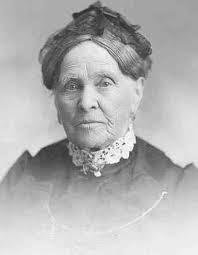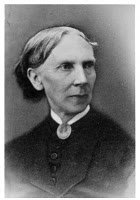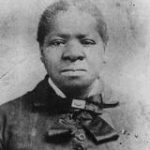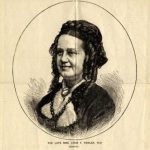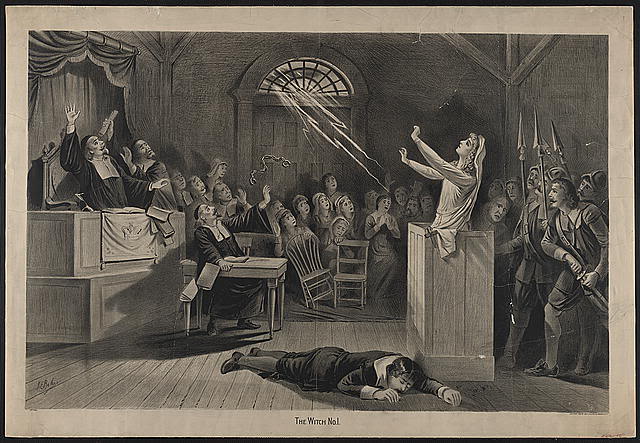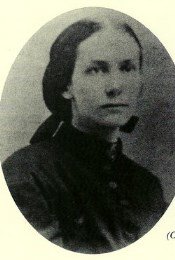Philanthropist and Founder of Bradley University
Lydia Moss Bradley (1816–1908) was a wealthy philanthropist famous for her humanitarian works in Illinois and the independent management of her wealth. A pioneer in business and philanthropy, she founded Bradley Polytechnic Institute (now Bradley University) in 1897. Bradley and her accomplishments would be notable in any age, but to achieve all of this as an independent woman in the 19th century makes her simply amazing.
Lydia Moss was born in Vevay, Indiana on July 31, 1816, the daughter of Zeally and Jennett Glasscock Moss. Prior to Lydia’s birth, Zeally Moss owned a plantation in Kentucky, but decided that he did not want to make a living based on slavery. He reportedly, “gave the place rent free to his Negroes to work out their own living, while he crossed over into free territory to make his home and rear his family.”
Lydia Moss Bradley believed that industriousness was required of all able-bodied members of a community. Despite her limited education – in a neighbor’s kitchen with no heat, few books and handmade quill pens – Lydia learned the practical things of life and developed the strong business sense that would serve her so well as an adult.
Lydia’s father gave a young colt that had lost its mother to his daughter to raise. After raising enough money for a saddle and bridle, and enjoying the horse as the only access to a social life in those days, she sold it in exchange for 40 acres of forested land. She cleared the land and sold the timber, and met Tobias Bradley, who was running the sawmill where her timber was processed.
Marriage and Family
On May 11, 1837, at age 31, Lydia married Tobias Bradley, and the newlyweds initially lived with her parents in Vevay. Their first child, Rebecca, was born January 20, 1839. That same year, Zeally Moss died leaving the family farm to Lydia. Lydia gave birth to their second daughter, Clarissa, on October, 26, 1843, but Rebecca died on September 2, 1845.
In 1847, Lydia and her family, including her mother, moved to Peoria, Illinois to join her brother William Moss. With the proceeds from the sale of their land holdings in Vevay, the Bradleys purchased a large tract of land in Peoria, which was in its early development, and an excellent place for Tobias Bradley and William Moss to prosper in business ventures.
Over the next three decades the Bradleys prospered in real estate and banking. In the early days, Lydia was the housewife and mother, while Tobias became a leading businessman with many entrepreneurial endeavors. He was one of the founders of First National Bank in Peoria and helped establish the first public library there.
Unfortunately, the Bradleys suffered the deaths of five of their six children in rapid succession. Daughter Rebecca had died in 1845 before the move to Illinois, while daughter Clarissa and son Tobias Moss (born April 28, 1847) died during the first year at Peoria. Daughter Mary lived less than a year, dying on April 25, 1852, and son William died August 25, 1855 at the age of two. Daughter Laura (born April 24, 1849) lived longer than any of the other children, dying in 1864 at the age of fourteen.
During these same difficult years, in business dealings the Bradleys were charmed and soon became quite wealthy. In the early days Tobias ran another sawmill, captained the steamboat Avalanche owned by William Moss, and joined Moss in a distilling business, which ran successfully for many years. Tobias also continued to purchase land and bought stock in new companies.
After losing all of their children, the Bradleys began thinking about constructing a monument to their deceased children. They discussed the idea of an orphanage, but Lydia later decided that such institutions were often ill-equipped to help young people acquire the skills needed to become independent, which was her main interest.
Then came the final blow in 1867 when Tobias Bradley was killed in a carriage accident at age 56. Rather than becoming absorbed in her own grief and allowing herself to be protected by her wealth, Lydia took over the management of her estate, which was valued at $500,000. Within ten years, the estate doubled to over $1 million and then doubled again.
At the time of his death, Tobias Bradley was the president of the First National Bank of Peoria. Lydia inherited the stock which he owned in the bank, and became a member of the Board of Directors. For twenty-five of the nearly thirty-four years she served as a board member, she held the position of Director. Although it is difficult to determine if any other women in the country held similar positions, it is possible the she was the first female member of a national bank board in the United States.
In 1869, just before marrying Edward Clark, Lydia Moss Bradley became the first American woman to draft a prenuptial agreement to protect her assets. She was savvy enough be careful with her wealth, and was unwilling to place herself in a position of vulnerability. The agreement, which Clark signed, declared that if the marriage did not last each would retain their individual holdings. Bradley and Clark divorced in 1873.
Career in Philanthropy
In Peoria, Bradley gave land to the Society of St. Francis to build a hospital, now known as the OSF St. Francis Medical Center. In 1884, she built the Bradley Home for Aged Women to care for widowed and childless women, and funded the construction of the Universalist church. She also donated over 100 acres of land to the City of Peoria for a park, later named in memory of her daughter Laura.
Lydia Moss Bradley finally decided that she wanted to establish a place of higher learning as a lasting memorial to her husband and children. She began investigating schools as models for the one she planned to endow through her will. In 1877 Bradley visited Rose Polytechnic Institute in Indiana which offered degrees in engineering and the sciences because she wanted to give young people “the most practical assistance at the best time of their lives to make them independent, self-supporting, useful men and women.”
During her research, Bradley learned that the cost of such a school would be far greater than the value of her estate, so she decided to continue her business efforts in order to fully endow a school of the highest standards. One of the ways in which she made such a substantial increase in her wealth was her ability to improve the quality of land.
She owned 680 acres of Manito Marsh; she had the land drained and built farm buildings and fences, and began cultivating the land for farming, but the crops did poorly. When the crops failed to improve over time, she sent samples of the soil to Champaign for analysis. The soil was very rich, but it lacked potash. By amending the soil, Bradley’s farms became successful.
The farmers working her land benefitted, the land became useful, neighboring farmers followed suit and improved their own crops, and the value of the land was increased dramatically. Bradley had purchased this marsh land for $10 per acre, and when the crops became successful, the lots sold for up to $140 per acre.
Bradley was a strong, independent woman at a time when women were still expected to be submissive, but her willingness to seek out experts to aid her in her decision making was perhaps the greatest key to her success. In 1885, after nearly doubling the value of the estate left to her by her husband, she hired W.W. Hammond as her business manager, starting a relationship which lasted until her death and beyond – Hammond managed the affairs of Bradley’s school until his own death in 1920.
Hiring Hammond was a wise decision because he was not only astute in business matters, he was also a lawyer and was subsequently able to protect her interests. Bradley met with Hammond every morning at her home, an imposing brick residence Tobias Bradley built in 1858. Every Sunday, she took a carriage ride to Springdale Cemetery and placed flowers from her own gardens on the graves of her deceased loved ones.
Bradley Polytechnic Institute
As a first step toward her goal of establishing a school, in 1892 Bradley purchased a controlling interest in Parsons Horological School in LaPorte, Indiana, the first school for watchmakers in America, and moved it to Peoria with its 100 students, full staff of teachers and all. She specified in her will that the school should be expanded after her death to include a classical education as well as industrial arts and home economics:
…it being the first object of this Institution to furnish its students with the means of living an independent, industrious and useful life by the aid of a practical knowledge of the useful arts and sciences.
One of the best pieces of advice Bradley received came from William Rainey Harper, president of the University of Chicago in October 1896. After looking over her finances he assured her she had sufficient funds, and soon convinced her to move ahead with her plans and establish the school during her lifetime.
Bradley Polytechnic Institute was chartered on November 13, 1896. Mrs. Bradley provided 17.5 acres of land, $170,000 for buildings, equipment and a library, and $30,000 per year for operating expenses. On April 10, 1897, ground was broken for Bradley Hall and work moved ahead quickly. With 14 faculty and 150 students, classes began in Bradley Hall on October 4, 1897 – with 500 workers still hammering away.
The Chicago Times Herald article about Mrs. Bradley at the school’s dedication on October 8, 1897 stated:
…in the few sentences she uttered were compressed the ideals she had cherished for half a century. She said she hoped the institute would be a real benefit to mankind; that it would be the means of making better men and women; that boys and girls would find in the new institution of learning an incentive to intellectual life was her ardent wish.
Later Years
Bradley knew that to safeguard her initial plans for the Bradley Polytechnic Institute, she could not leave many issues open to interpretation. She purposely placed a majority of Peorians on the board and had the ratio of residents written into the charter to make certain the school always served the interests of the community.
Establishing the school during her lifetime gave Lydia Moss Bradley the enormous emotional satisfaction of seeing the creation brought about by her efforts. All records indicate that she rarely missed special events at the Institute. She is said to have entertained students in her kitchen and garden some afternoons, and she is almost always reported to have been an honored guest on founder’s days and graduations.
In many speeches and memorial addresses after her death, those who knew her felt that the Institute had a profound effect on Bradley’s happiness in her later years. Students, faculty and trustees were also glad that they had the opportunity to express their appreciation to their school’s founder while she lived. Without that satisfaction, she would have had far less reason to live such a long and active life.
Pleased with its progress, Mrs. Bradley transferred to the school the rest of her estate, including nearly 1,000 different pieces of property, reserving its use and profits during her lifetime. At Founder’s Day in 1906 she announced an additional gift to build Hewitt Gymnasium, now Hartmann Center for the Performing Arts.
By 1899 the Institute had expanded to accommodate nearly 500 pupils, about equally divided between men and women, and offered courses in biology, chemistry, food work, sewing, English, German, French, Latin, Greek, history, manual arts, drawing, mathematics and physics.
Lydia Moss Bradley developed deep convictions on work, skill, thrift and economy. Although her family had become quite prosperous in land holdings during her childhood, every member of the family worked on the farm. Even in her later years as one of the wealthiest citizens in the Peoria area, business manager W. W. Hammond reported:
Mrs. Bradley never forgot how to work, and till within a short time of her death still made her own butter, raised her own eggs, salted down her own meat and tried out her own lard. She would not have considered herself a good housekeeper had she not done so. The housewife of those times was expected to stock the larder with meats and fruits, to spin the yarn, make the clothing, bedding and carpets, and to prepare food in plenty for all who chanced to be present when meal time came round. All these things Mrs. Bradley did.
Lydia Moss Bradley died on January 16, 1908, at age 91.
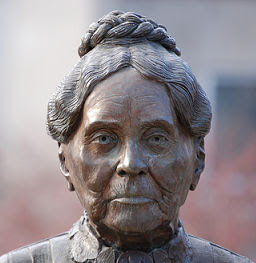
Image: Lydia Moss Bradley Monument
Founder’s Circle, Bradley University
Peoria, Illinois
The Institute continued to grow and develop to meet the educational needs of the region. It became a four-year college offering bachelor’s degrees in 1920 and a full university with graduate programs in 1946, when it was renamed Bradley University. Today it is a fully accredited institution that provides education in engineering, business, communication, teacher education, nursing, physical therapy, fine arts and the liberal arts and sciences.
In 1998, Bradley was inducted into the National Women’s Hall of Fame.
SOURCES
Wikipedia: Bradley University
Wikipedia: Lydia Moss Bradley
Lydia Moss Bradley from Peoria
